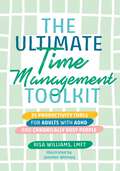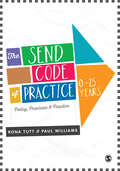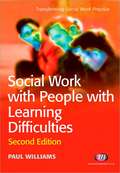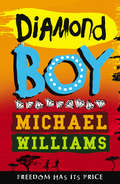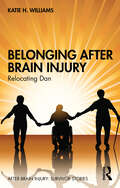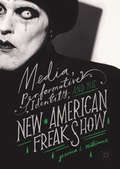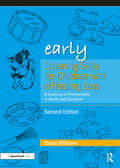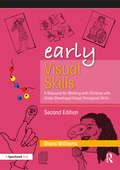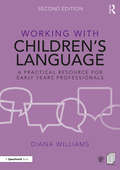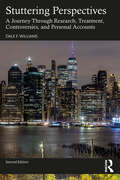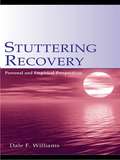- Table View
- List View
The Ultimate Time Management Toolkit: 25 Productivity Tools for Adults with ADHD and Chronically Busy People (Ultimate Toolkits for Psychological Wellbeing)
by Risa WilliamsDo you find time constantly slipping away from you? Or does completing a to-do list feel totally unachievable? We all have 24 hours in a day, but sometimes putting them to good use can feel like an impossible task. The Ultimate Time Management Toolkit is here to change that!Written by a clinical therapist and author of The Ultimate Anxiety Toolkit, this book focuses on practical methods and strategies, including creative worksheets and easy to use techniques, to help you find your motivation, achieve your goals and feel less stressed about organizing your time.With 25 different techniques based on CBT, mindfulness and narrative therapy, you can find out which strategies work best for you to help transform how you use your time and learn how to feel empowered to make positive changes to habits in your daily life.
Learning Disabilities and e-Information: Navigating the Electronic Hypermaze
by Peter WilliamsDigital Technology is becoming ever more used by people with learning disabilities for information, entertainment and to enjoy self-expression. Despite this, there is a paucity of research into how this cohort negotiate electronic interfaces, interpret images, navigate pages and read online; what barriers there might be, and how these could be obviated. This book explores these issues, establishing how these and other factors facilitate or inhibit information access and behaviour more generally. There are plenty of guidelines and accessibility standards regarding electronic information presentation, but most are outdated or have been formulated without empirical evidence. Unlike prior literature this book is the result of many years's research in the field, considers specific information contexts, and develops new concepts in information behaviour. It is written in non-technical, jargon-free language, relevant for academics, students and professionals; from human-computer interaction researchers, learning disability specialists and information scientists to formal and informal carers and supporters, college tutors, family members and others.
Learning Disabilities and e-Information: Navigating the Electronic Hypermaze
by Peter WilliamsDigital Technology is becoming ever more used by people with learning disabilities for information, entertainment and to enjoy self-expression. Despite this, there is a paucity of research into how this cohort negotiate electronic interfaces, interpret images, navigate pages and read online; what barriers there might be, and how these could be obviated. This book explores these issues, establishing how these and other factors facilitate or inhibit information access and behaviour more generally. There are plenty of guidelines and accessibility standards regarding electronic information presentation, but most are outdated or have been formulated without empirical evidence. Unlike prior literature this book is the result of many years's research in the field, considers specific information contexts, and develops new concepts in information behaviour. It is written in non-technical, jargon-free language, relevant for academics, students and professionals; from human-computer interaction researchers, learning disability specialists and information scientists to formal and informal carers and supporters, college tutors, family members and others.
The SEND Code of Practice 0-25 Years: Policy, Provision and Practice
by Paul Williams Rona TuttConsidering it for your course reading list? Lecturers can order their e-inspection copy here today! How have you found the changes brought about by the new SEND Code of Practice: 0-25 years (2014)? This book is the ultimate guide to making sure that you are not only meeting the requirements, but are improving outcomes for children and young people as well. Written for all professionals working in the field, it covers: · The broader Children and Families Act (2014) · The role of the local authority · Guidance on all the key changes that school leaders, SENCO's, and staff are concerned about · Case studies of settings across the 0-25 age range, including maintained schools, academies, free schools, and specialist and alternative provision. Whether you work in education, health, or social care, or are training to do so, this book will genuinely improve your provision and practice for children and young people with SEND.
Social Work with People with Learning Difficulties
by Paul WilliamsCurrent practice in the field is driven by the government White Paper 'Valuing People' (2001), which declared radical aims for services for people with learning difficulties. This fully revised second edition includes key updates on this White Paper and provides an up-to-date evaluation of the progress made towards those aims. Using case studies, activities and further reading to reinforce learning, this book explores an important area of social work practice and examines the varied roles social workers might undertake - including the achievements and satisfaction of working with service users with learning difficulties and challenges.
Diamond Boy
by Michael Williams'Diamonds for everyone.' That's what fifteen-year-old Patson Moyo hears when his family arrives in the Marange diamond fields, leaving his previous life, school and friends behind with hopes for a better life. Soon Patson is working in the mines along with four friends in the Gwejana Syndicate – teen diamond miners, secretly pooling their profits and hoping to find the priceless stone that will change everything. But when the government's soldiers come to Marange, Patson's world is shattered. Set against the backdrop of President Mugabe's brutal regime in Zimbabwe, this is the story of a young man who succumbs to greed, but finds his way out through a transformative journey to South Africa in search of his missing sister, in search of freedom, and in search of himself.
Positive Behaviour Management in Early Years Settings: An Essential Guide
by Liz WilliamsInformed by the author's wealth of practical experience, this is an essential guide to promoting positive behaviour in early years settings. It explains why children may act the way they do, describes the key factors in promoting appropriate behaviour and provides a range of easy to use techniques for improving behaviour and supporting development.
Positive Behaviour Management in Primary Schools: An Essential Guide
by Liz WilliamsThis highly accessible and much-needed resource sets out practical advice on positive behaviour management in primary schools, exploring how to support children effectively with their personal, social and emotional development.With an emphasis on implementable strategies, this book will give primary school teachers and staff an understanding as to why children may behave as they do, and what steps can be taken by the school to support a child's development. Considering a variety of factors that influence positive behaviour, such as environment, mental health, parents, and the importance of planning, this book is full of ideas that can be dipped in and out of for support in the classroom. Bite-sized and practical, this is a perfect book for busy teachers.
Belonging After Brain Injury: Relocating Dan (After Brain Injury: Survivor Stories)
by Katie H. WilliamsBelonging After Brain Injury: Relocating Dan explores the life of the author’s brother who has dealt with the effects of a severe traumatic brain injury (TBI) for over four decades. It recounts the institutional, psychological, and social labyrinths he and his family have navigated following the TBI he sustained at the age of eighteen. This insightful volume offers a holistic account of the impact of TBI on the survivor and his family. It reveals the difficulties a TBI survivor has had to endure and provides practical information about physical, psychological, and psychosocial symptoms and their consequences. Dan’s story offers new perspectives and strategies that will help alleviate seemingly intractable problems and highlights the central importance of forming connections with others in order to lead a fuller life. The author’s account of her own journey, learning to help care for and advocate for Dan, offers an invaluable guide for TBI survivors and those who care for and support them. Belonging After Brain Injury: Relocating Dan will be of interest to TBI survivors and their families. Its rich insights will be essential reading for medical and mental health professionals, as well those involved in the care and rehabilitation of TBI survivors and families.
Belonging After Brain Injury: Relocating Dan (After Brain Injury: Survivor Stories)
by Katie H. WilliamsBelonging After Brain Injury: Relocating Dan explores the life of the author’s brother who has dealt with the effects of a severe traumatic brain injury (TBI) for over four decades. It recounts the institutional, psychological, and social labyrinths he and his family have navigated following the TBI he sustained at the age of eighteen. This insightful volume offers a holistic account of the impact of TBI on the survivor and his family. It reveals the difficulties a TBI survivor has had to endure and provides practical information about physical, psychological, and psychosocial symptoms and their consequences. Dan’s story offers new perspectives and strategies that will help alleviate seemingly intractable problems and highlights the central importance of forming connections with others in order to lead a fuller life. The author’s account of her own journey, learning to help care for and advocate for Dan, offers an invaluable guide for TBI survivors and those who care for and support them. Belonging After Brain Injury: Relocating Dan will be of interest to TBI survivors and their families. Its rich insights will be essential reading for medical and mental health professionals, as well those involved in the care and rehabilitation of TBI survivors and families.
My Son's Not Rainman: One Man, One Autistic Boy, A Million Adventures
by John WilliamsThis isn’t a story about autism. It’s a story about a young boy who happens to have autism, and there is a difference.John Williams is a stand-up comedian. He is also a single father and full-time carer for his son, who has autism and cerebral palsy. This is their incredible story.In 2012, John started a blog called My Son’s Not Rainman, a heartfelt and uplifting account of everyday life for him and ‘The Boy’. Following on from the blog’s amazing success, John felt there was still much more of their life, past and present, that he wanted to share. And not only of the challenges of bringing up a child who for too long was just dismissed as ‘difficult’, but also of the joy of living with someone who looks at the world in a unique way.My Son’s Not Rainman radiates warmth, care and passion, not to mention laugh-out-loud humour, on every page. It is a brilliantly different story about a brilliantly different boy.
Supporting the Development of Speech, Language and Communication in the Early Years: Includes Downloadable Assessment Tools, Checklists, Recording Forms, Advice and Information Leaflets and Intervention Strategies
by Jo Williams Diana McQueenSpeech and language impairment can have a huge impact on cognitive development. Identifying what is going wrong - and what effective intervention looks like - can be daunting. Short of retraining you as a speech and language therapist, this thorough guide will give you everything you need to change that.An essential resource, the book contains a wide variety of online resources, including phonological and sound awareness documents, assessment tools, and recording forms that can be downloaded straight to your device, providing excellent materials and activities to use in the classroom.Written by speech and language therapists and designed exclusively for Early Years practitioners, this book provides a complete overview of how children acquire language and what language impairments look like at this age. You will find both strategic and practical advice on how to manage and encourage the development of speech and language skills. Creating the optimum communication environment for every child in your setting is an important part of what the book offers. Equally, practitioners are supported to be able to recognise the features of specific language difficulties such as Developmental Language Disorder (DLD) and feel confident to intervene when children are struggling.
Media, Performative Identity, and the New American Freak Show
by Jessica L. WilliamsThis book traces how the American freak show has re-emerged in new visual forms in the 21st century. It explores the ways in which moving image media transmits and contextualizes, reinterprets and appropriates, the freak show model into a “new American freak show.” It investigates how new freak representations introduce narratives about sex, gender, and cultural perceptions of people with disabilities. The chapters examine such representations found in horror films, including a prolonged look at Freaks (1932) and The Texas Chainsaw Massacre (1974), documentaries such as Murderball (2005) and TLC’s Push Girls (2012-present), disability pornography including the pornographic documentary Sick: The Life and Death of Bob Flanagan Supermasochist (1997), and the music icons Marilyn Manson and Lady Gaga in their portrayals of disability and freakishness. Through this book we learn that the visual culture that has emerged takes the place of the traditional freak show but opens new channels of interpretation and identification through its use of mediated images as well as the altered freak-norm relationship that it has fostered. In its illumination of the relationship between normal and freakish bodies through different media, this book will appeal to students and academics interested in disability studies, gender studies, film theory, critical race theory, and cultural studies.
Media, Performative Identity, and the New American Freak Show
by Jessica L. WilliamsThis book traces how the American freak show has re-emerged in new visual forms in the 21st century. It explores the ways in which moving image media transmits and contextualizes, reinterprets and appropriates, the freak show model into a “new American freak show.” It investigates how new freak representations introduce narratives about sex, gender, and cultural perceptions of people with disabilities. The chapters examine such representations found in horror films, including a prolonged look at Freaks (1932) and The Texas Chainsaw Massacre (1974), documentaries such as Murderball (2005) and TLC’s Push Girls (2012-present), disability pornography including the pornographic documentary Sick: The Life and Death of Bob Flanagan Supermasochist (1997), and the music icons Marilyn Manson and Lady Gaga in their portrayals of disability and freakishness. Through this book we learn that the visual culture that has emerged takes the place of the traditional freak show but opens new channels of interpretation and identification through its use of mediated images as well as the altered freak-norm relationship that it has fostered. In its illumination of the relationship between normal and freakish bodies through different media, this book will appeal to students and academics interested in disability studies, gender studies, film theory, critical race theory, and cultural studies.
The Self-Help Guide for Special Kids and their Parents
by James Matthew Williams Joan MatthewsJames Williams is an SP or special person - he was diagnosed with autism during early childhood. His mother, Joan Matthews, is an NP or normal person. As James grew up, his different perception of the world and the lack of understanding from NPs created problems. Together, he and his mother met the challenges with ingenuity and humour. One day, while taking a walk, James and Joan decided to write a book of their practical solutions. The Self-Help Guide for Special Kids is that book. Covering everything from eye sensitivity, to knowing how far away to stand from other people, to being polite when someone is crying, James and Joan's book describes the problems that an SP may face, and the solutions which they have found to work successfully. Pervaded by their caustic humour and common sense, The Self-Help Guide for Special Kids will be invaluable to other SPs and their families both as a source of advice and a fresh and witty account of how it feels to be an SP.
The Jumbled Jigsaw: An Insider's Approach to the Treatment of Autistic Spectrum `Fruit Salads'
by Donna WilliamsThis book exposes autism spectrum disorders as a combination of a whole range of often underlying conditions. Exploring everything from mood, anxiety, obsessive-compulsive and tic disorders to information processing and sensory perceptual difficulties and more, Donna demonstrates how such conditions can combine to form a 'cluster condition'.
Early Listening Skills for Children with a Hearing Loss: A Resource for Professionals in Health and Education (Early Skills)
by Diana WilliamsNow in a revised and updated second edition, Early Listening Skills is a practical manual for use with children and young people with underdeveloped listening skills related to hearing loss. Thirteen clear and easy to follow sections focus on skills such as auditory detection, discrimination, recognition, sequencing and memory. Each one is filled with a series of carefully designed activities to stimulate and develop auditory awareness and discrimination skills in children with a range of developmental levels and abilities. Features include: A wide range of activities suited to both the early years and home settings Links to the Early Years Foundation Stage (EYFS) framework and topics reflecting the EYFS and Key Stage 1 curriculum Photocopiable material designed to document the child’s development over time As most of the activities are non-verbal, they are well suited for children with limited spoken language as well as children with special educational needs and disability and English as an additional language (EAL) learners. Whilst primarily designed for early years practitioners, special educational needs co-ordinators (SENCOs), specialist teachers, therapists and other professionals, the activity sheets and guidance also make it an invaluable tool for parents and caregivers looking to stimulate listening skills at home.
Early Visual Skills: A Resource for Working with Children with Under-Developed Visual Perceptual Skills (Early Skills)
by Diana WilliamsNow in a revised and updated second edition, Early Visual Skills is a practical manual for use with children and young people who have underdeveloped visual perceptual skills. Twelve clear and easy-to-follow sections, focusing on skills such as attention, discrimination, sequencing, concentration and memory, are filled with carefully designed activities to stimulate visual attention and discrimination skills in children with a range of developmental levels and abilities. Features include: A wide range of activities suited to both the early years and home settings Links to the Early Years Foundation Stage (EYFS) framework and topics reflecting the EYFS and the Key Stage 1 curriculum Photocopiable materials designed to document the child’s development over time As most of the activities are non-verbal, they are well suited for children with limited spoken language, including EAL (English as an Additional Language) learners, the deaf, sensory impaired, or those with autism or learning difficulties. Whilst primarily designed for early years practitioners, SENCOs (Special Educational Needs Coordinator), specialist teachers, therapists and other professionals, there are activity sheets and guidance for parents to provide them practical advice on how to stimulate visual perceptual skills at home, turning their child’s everyday routines into opportunities to stimulate visual awareness.
Working with Children’s Language: A Practical Resource for Early Years Professionals (Working With)
by Diana WilliamsThis revised and updated second edition of Working with Children’s Language has been created to support practitioners who work with young children with delayed language acquisition. Rooted in a developmental theory of language learning, it covers topics such as attention control and listening, the role of play, verbal comprehension and the acquisition of spoken expressive language. Each chapter offers a straightforward overview of current research relating to the specific language skill before introducing a wealth of targeted games and activities that can help support the development of those skills. Key features include: • A structured approach to language learning that can be followed as a programme or adapted for informal use by individual practitioners. • Accessible activities, games and ideas suitable for small group or individual intervention, linked to specific aims based on developmental norms. • Photocopiable and downloadable resources, including a record sheet to track progress in each skill against aims and outcomes for individual children. Clearly linking theory and practice in an engaging and easy-to-follow format, this is an invaluable resource to support children in early years settings and Key Stage 1 whose language is delayed, but who are otherwise developing normally. It is a must-have book for early years practitioners, teachers, SEND professionals and speech and language therapists with varying levels of experience.
Working with Children’s Language: A Practical Resource for Early Years Professionals (Working With)
by Diana WilliamsThis revised and updated second edition of Working with Children’s Language has been created to support practitioners who work with young children with delayed language acquisition. Rooted in a developmental theory of language learning, it covers topics such as attention control and listening, the role of play, verbal comprehension and the acquisition of spoken expressive language. Each chapter offers a straightforward overview of current research relating to the specific language skill before introducing a wealth of targeted games and activities that can help support the development of those skills. Key features include: • A structured approach to language learning that can be followed as a programme or adapted for informal use by individual practitioners. • Accessible activities, games and ideas suitable for small group or individual intervention, linked to specific aims based on developmental norms. • Photocopiable and downloadable resources, including a record sheet to track progress in each skill against aims and outcomes for individual children. Clearly linking theory and practice in an engaging and easy-to-follow format, this is an invaluable resource to support children in early years settings and Key Stage 1 whose language is delayed, but who are otherwise developing normally. It is a must-have book for early years practitioners, teachers, SEND professionals and speech and language therapists with varying levels of experience.
Stuttering Perspectives: A Journey Through Research, Treatment, Controversies, and Personal Accounts
by Dale F. WilliamsStuttering Perspectives is a highly engaging book that interweaves discussion and research about stuttering with personal accounts. Written in a reader-friendly and informal style, the book considers stuttering from a variety of angles, providing the reader with a nuanced and holistic view. In this way, topics such as therapy, support groups, listener reactions, and many others are not only explained within the context of current research, but also illustrated with lively examples demonstrating the stuttering experience. Fully updated in its second edition, the book includes new stories, additional discussion questions, and inclusion of contemporary stuttering issues not contained in the original version. This book is highly relevant reading for speech and language professionals, as well as students of communication sciences and disorders. It will also be of great interest to people who stutter and anyone with an interest in fluency disorders.
Stuttering Perspectives: A Journey Through Research, Treatment, Controversies, and Personal Accounts
by Dale F. WilliamsStuttering Perspectives is a highly engaging book that interweaves discussion and research about stuttering with personal accounts. Written in a reader-friendly and informal style, the book considers stuttering from a variety of angles, providing the reader with a nuanced and holistic view. In this way, topics such as therapy, support groups, listener reactions, and many others are not only explained within the context of current research, but also illustrated with lively examples demonstrating the stuttering experience. Fully updated in its second edition, the book includes new stories, additional discussion questions, and inclusion of contemporary stuttering issues not contained in the original version. This book is highly relevant reading for speech and language professionals, as well as students of communication sciences and disorders. It will also be of great interest to people who stutter and anyone with an interest in fluency disorders.
Stuttering Recovery: Personal and Empirical Perspectives
by Dale F. WilliamsStuttering Recovery: Personal and Empirical Perspectives is a highly original and engaging book serving to not only educate readers on topics related to stuttering, but also to stimulate discussion. The author interweaves personal accounts of people who stutter with informational chapters highlighting up-to-date research on recovery-related issues such as therapy, support groups, listener reactions, risk-taking, and dealing with family members and significant others.Reader-friendly and understandable, this book incorporates various perspectives to teach and illustrate the different aspects of recovery. Chapters are paired with stories presenting all sides of the recovery process -- the humorous and serious, the uplifting and frustrating, the thoughtful and emotional, and everything in-between. The result is a text that is entertaining and instructive.Stuttering Recovery: Personal and Empirical Perspectives is intended for undergraduate and graduate students, clinicians, speech-language professionals, people who stutter, significant others, and anyone else who has an interest in fluency disorders.
Stuttering Recovery: Personal and Empirical Perspectives
by Dale F. WilliamsStuttering Recovery: Personal and Empirical Perspectives is a highly original and engaging book serving to not only educate readers on topics related to stuttering, but also to stimulate discussion. The author interweaves personal accounts of people who stutter with informational chapters highlighting up-to-date research on recovery-related issues such as therapy, support groups, listener reactions, risk-taking, and dealing with family members and significant others.Reader-friendly and understandable, this book incorporates various perspectives to teach and illustrate the different aspects of recovery. Chapters are paired with stories presenting all sides of the recovery process -- the humorous and serious, the uplifting and frustrating, the thoughtful and emotional, and everything in-between. The result is a text that is entertaining and instructive.Stuttering Recovery: Personal and Empirical Perspectives is intended for undergraduate and graduate students, clinicians, speech-language professionals, people who stutter, significant others, and anyone else who has an interest in fluency disorders.
Intervention and Support for Parents and Carers of Children and Young People on the Autism Spectrum: A Resource for Trainers (PDF)
by Christopher Williams Joanne BrayshawThe needs of parents and carers of children on the autism spectrum are not met by conventional parenting strategies. This resource for trainers and facilitators offers the best available knowledge and theories to help them develop an understanding of how their child perceives the world and ultimately improve their family life. The manual is divided into ten sessions that introduce a topic related to autism and Asperger Syndrome, for example, 'mindblindness' and the social world, and strategies to manage individual behaviour. During each session parents are introduced to a new topic and are invited to participate in exercises and group discussions that serve to reinforce the key messages discussed earlier. Each session closes with recommended reading and 'homework'. This manual is a valuable resource for professionals working with parents of children and young people with autism and Asperger Syndrome and is an effective complement to How to Live with Autism and Asperger Syndrome: Practical Strategies for Parents and Professionals published by Jessica Kingsley Publishers, which is referenced throughout the resource.
